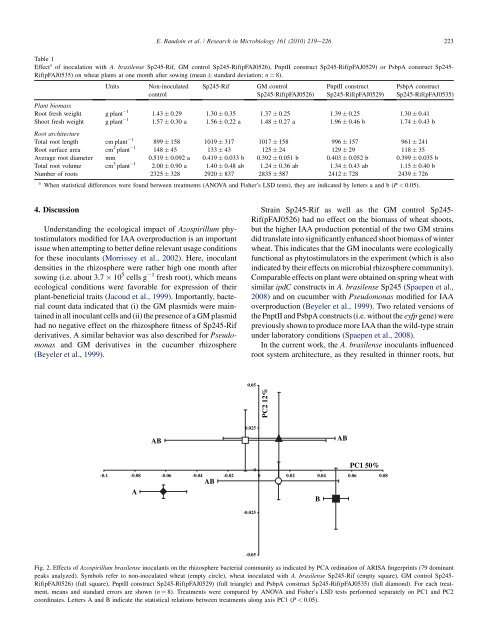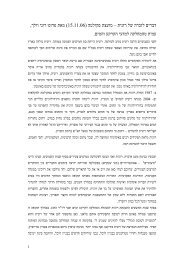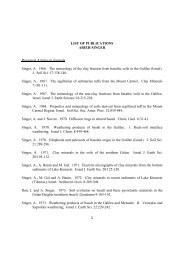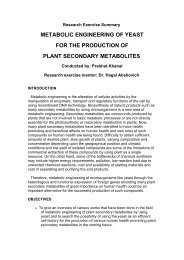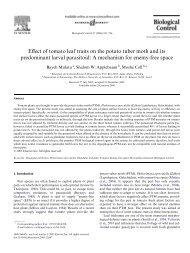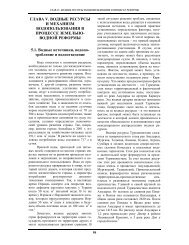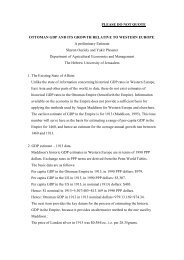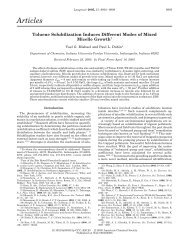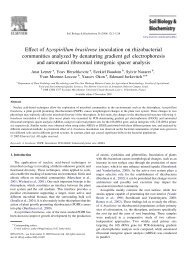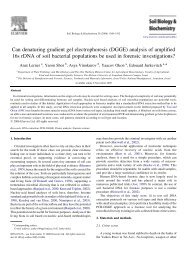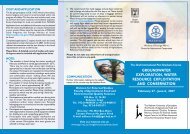Effects of Azospirillum brasilense with genetically modified auxin ...
Effects of Azospirillum brasilense with genetically modified auxin ...
Effects of Azospirillum brasilense with genetically modified auxin ...
You also want an ePaper? Increase the reach of your titles
YUMPU automatically turns print PDFs into web optimized ePapers that Google loves.
E. Baudoin et al. / Research in Microbiology 161 (2010) 219e226<br />
223<br />
Table 1<br />
Effect a <strong>of</strong> inoculation <strong>with</strong> A. <strong>brasilense</strong> Sp245-Rif, GM control Sp245-Rif(pFAJ0526), PnptII construct Sp245-Rif(pFAJ0529) or PsbpA construct Sp245-<br />
Rif(pFAJ0535) on wheat plants at one month after sowing (mean standard deviation; n ¼ 8).<br />
Plant biomass<br />
Root fresh weight<br />
Shoot fresh weight<br />
Units<br />
g plant<br />
g plant<br />
1<br />
1<br />
Non-inoculated<br />
control<br />
Sp245-Rif<br />
GM control<br />
Sp245-Rif(pFAJ0526)<br />
PnptII construct<br />
Sp245-Rif(pFAJ0529)<br />
PsbpA construct<br />
Sp245-Rif(pFAJ0535)<br />
1.43 0.29 1.30 0.35 1.37 0.25 1.39 0.25 1.30 0.41<br />
1.57 0.30 a 1.56 0.22 a 1.48 0.27 a 1.96 0.46 b 1.74 0.43 b<br />
Root architecture<br />
Total root length cm plant<br />
1<br />
899 158 1019 317 1017 158 996 157 961 241<br />
Root surface area cm 2 plant<br />
1<br />
148 45 133 43 125 24 129 29 118 35<br />
Average root diameter mm 0.519 0.092 a 0.419 0.033 b 0.392 0.051 b 0.403 0.052 b 0.399 0.035 b<br />
Total root volume cm 3 plant<br />
1<br />
2.00 0.90 a 1.40 0.48 ab 1.24 0.36 ab 1.34 0.43 ab 1.15 0.40 b<br />
Number <strong>of</strong> roots 2325 328 2920 837 2835 587 2412 728 2439 726<br />
a When statistical differences were found between treatments (ANOVA and Fisher’s LSD tests), they are indicated by letters a and b (P < 0.05).<br />
4. Discussion<br />
Understanding the ecological impact <strong>of</strong> <strong>Azospirillum</strong> phytostimulators<br />
<strong>modified</strong> for IAA overproduction is an important<br />
issue when attempting to better define relevant usage conditions<br />
for these inoculants (Morrissey et al., 2002). Here, inoculant<br />
densities in the rhizosphere were rather high one month after<br />
sowing (i.e. about 3.7 10 5 cells g 1 fresh root), which means<br />
ecological conditions were favorable for expression <strong>of</strong> their<br />
plant-beneficial traits (Jacoud et al., 1999). Importantly, bacterial<br />
count data indicated that (i) the GM plasmids were maintained<br />
in all inoculant cells and (ii) the presence <strong>of</strong> a GM plasmid<br />
had no negative effect on the rhizosphere fitness <strong>of</strong> Sp245-Rif<br />
derivatives. A similar behavior was also described for Pseudomonas<br />
and GM derivatives in the cucumber rhizosphere<br />
(Beyeler et al., 1999).<br />
Strain Sp245-Rif as well as the GM control Sp245-<br />
Rif(pFAJ0526) had no effect on the biomass <strong>of</strong> wheat shoots,<br />
but the higher IAA production potential <strong>of</strong> the two GM strains<br />
did translate into significantly enhanced shoot biomass <strong>of</strong> winter<br />
wheat. This indicates that the GM inoculants were ecologically<br />
functional as phytostimulators in the experiment (which is also<br />
indicated by their effects on microbial rhizosphere community).<br />
Comparable effects on plant were obtained on spring wheat <strong>with</strong><br />
similar ipdC constructs in A. <strong>brasilense</strong> Sp245 (Spaepen et al.,<br />
2008) and on cucumber <strong>with</strong> Pseudomonas <strong>modified</strong> for IAA<br />
overproduction (Beyeler et al., 1999). Two related versions <strong>of</strong><br />
the PnptII and PsbpA constructs (i.e. <strong>with</strong>out the eyfp gene) were<br />
previously shown to produce more IAA than the wild-type strain<br />
under laboratory conditions (Spaepen et al., 2008).<br />
In the current work, the A. <strong>brasilense</strong> inoculants influenced<br />
root system architecture, as they resulted in thinner roots, but<br />
0.05<br />
PC2 12%<br />
AB<br />
0.025<br />
AB<br />
0<br />
-0.1 -0.08 -0.06 -0.04 -0.02 0 0.02 0.04 0.06 0.08<br />
AB<br />
A<br />
B<br />
-0.025<br />
PC1 50%<br />
Fig. 2. <strong>Effects</strong> <strong>of</strong> <strong>Azospirillum</strong> <strong>brasilense</strong> inoculants on the rhizosphere bacterial community as indicated by PCA ordination <strong>of</strong> ARISA fingerprints (79 dominant<br />
peaks analyzed). Symbols refer to non-inoculated wheat (empty circle), wheat inoculated <strong>with</strong> A. <strong>brasilense</strong> Sp245-Rif (empty square), GM control Sp245-<br />
Rif(pFAJ0526) (full square), PnptII construct Sp245-Rif(pFAJ0529) (full triangle) and PsbpA construct Sp245-Rif(pFAJ0535) (full diamond). For each treatment,<br />
means and standard errors are shown (n ¼ 8). Treatments were compared by ANOVA and Fisher’s LSD tests performed separately on PC1 and PC2<br />
coordinates. Letters A and B indicate the statistical relations between treatments along axis PC1 (P < 0.05).<br />
-0.05


